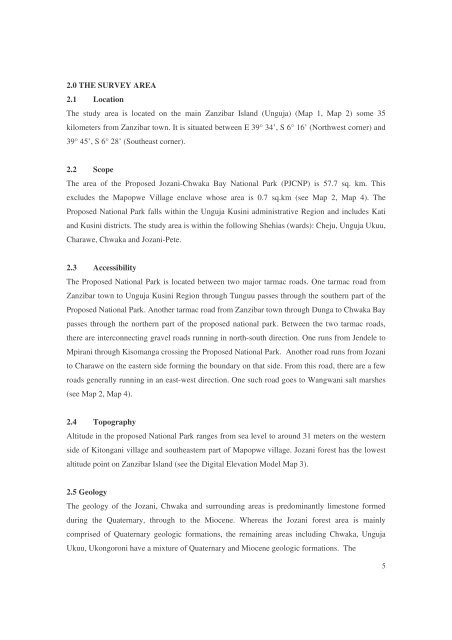Jozani biodiversity inventory report 2002 - Coastal Forests of Kenya ...
Jozani biodiversity inventory report 2002 - Coastal Forests of Kenya ...
Jozani biodiversity inventory report 2002 - Coastal Forests of Kenya ...
You also want an ePaper? Increase the reach of your titles
YUMPU automatically turns print PDFs into web optimized ePapers that Google loves.
2.0 THE SURVEY AREA<br />
2.1 Location<br />
The study area is located on the main Zanzibar Island (Unguja) (Map 1, Map 2) some 35<br />
kilometers from Zanzibar town. It is situated between E 39° 34’, S 6° 16’ (Northwest corner) and<br />
39° 45’, S 6° 28’ (Southeast corner).<br />
2.2 Scope<br />
The area <strong>of</strong> the Proposed <strong>Jozani</strong>-Chwaka Bay National Park (PJCNP) is 57.7 sq. km. This<br />
excludes the Mapopwe Village enclave whose area is 0.7 sq.km (see Map 2, Map 4). The<br />
Proposed National Park falls within the Unguja Kusini administrative Region and includes Kati<br />
and Kusini districts. The study area is within the following Shehias (wards): Cheju, Unguja Ukuu,<br />
Charawe, Chwaka and <strong>Jozani</strong>-Pete.<br />
2.3 Accessibility<br />
The Proposed National Park is located between two major tarmac roads. One tarmac road from<br />
Zanzibar town to Unguja Kusini Region through Tunguu passes through the southern part <strong>of</strong> the<br />
Proposed National Park. Another tarmac road from Zanzibar town through Dunga to Chwaka Bay<br />
passes through the northern part <strong>of</strong> the proposed national park. Between the two tarmac roads,<br />
there are interconnecting gravel roads running in north-south direction. One runs from Jendele to<br />
Mpirani through Kisomanga crossing the Proposed National Park. Another road runs from <strong>Jozani</strong><br />
to Charawe on the eastern side forming the boundary on that side. From this road, there are a few<br />
roads generally running in an east-west direction. One such road goes to Wangwani salt marshes<br />
(see Map 2, Map 4).<br />
2.4 Topography<br />
Altitude in the proposed National Park ranges from sea level to around 31 meters on the western<br />
side <strong>of</strong> Kitongani village and southeastern part <strong>of</strong> Mapopwe village. <strong>Jozani</strong> forest has the lowest<br />
altitude point on Zanzibar Island (see the Digital Elevation Model Map 3).<br />
2.5 Geology<br />
The geology <strong>of</strong> the <strong>Jozani</strong>, Chwaka and surrounding areas is predominantly limestone formed<br />
during the Quaternary, through to the Miocene. Whereas the <strong>Jozani</strong> forest area is mainly<br />
comprised <strong>of</strong> Quaternary geologic formations, the remaining areas including Chwaka, Unguja<br />
Ukuu, Ukongoroni have a mixture <strong>of</strong> Quaternary and Miocene geologic formations. The<br />
5
















